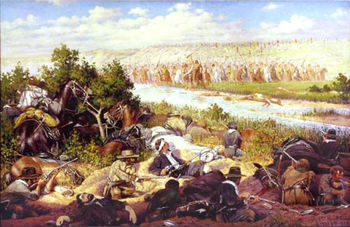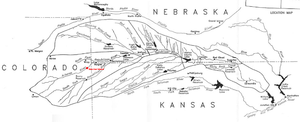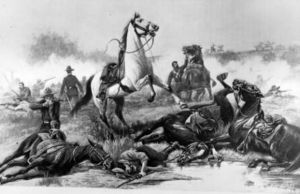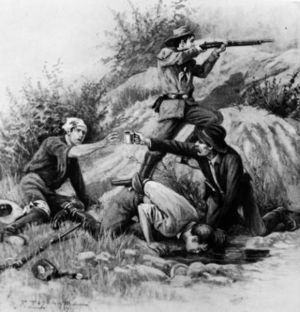Battle of Beecher Island
The Battle of Beecher Island (September 17–September 19, 1868), also known as the Battle of Arikaree Fork, was an armed conflict between elements of the United States Army and several of the Plains Indian tribes. Beecher Island on the Arikaree River, near present-day Wray, Colorado, was named afterwards for Lieutenant Fredrick H. Beecher (nephew of Henry Ward Beecher), one of the key leaders of the Army elements who was killed during the battle.
Background
In the summer and fall of 1868, continuing their annual seasonal raiding activities between the Arkansas and Platte Rivers in what was also the region of their best buffalo hunting, bands of Cheyenne and Arapaho Indians conducted raids against whites throughout the western Great Plains in Kansas. In addition they found incentive in the warfare that had been waged specifically against their clans by the military in 1867, and by memories of such atrocities as the Sand Creek massacre. Finally, the westward movement of the transcontinental railroad had stretched all the way across Kansas, bringing with it with many permanent white settlements. During the 1867-1868, the Cheyenne were in schism, with those advocating peace (possibly a majority) retreating south out of Kansas and the younger, intractable warrior societies continuing to raid. The latter during the summer of 1867 had successfully avoided a large expedition commanded by Major General Winfield S. Hancock, and in the process had garnered sympathy from Americans in the East who supported peaceful negotiations after Hancock attempted to bully the Cheyennes to submit and burned their abandoned villages when they did not.
In August of 1868, General Philip Sheridan, having replaced Hancock in command of the Department of the Missouri, was asked by acting Governor Frank Hall of Colorado for assistance after 79 settlers were killed in repeated attacks on farms, ranches, way stations, and travelers. Sheridan's main effort was to be made south of the Arkansas, a winter campaign in the Indian Territory, but he remained active in Kansas during the warmer weather, patrolling the Arkansas with the 7th Cavalry Regiment and the area between the Republican and Smoky Hill Rivers using the 10th Cavalry. To protect the railroad, Sheridan ordered his aide, Major George Alexander Forsyth of the 9th Cavalry Regiment, a Civil War veteran, to raise a company of civilian scouts to seek out and engage the marauders using their tactics, rather than those of the army. Forsyth hand-picked 48 men at Fort Hays, all armed with Spencer repeating rifles. Forsyth's executive officer was Lieutenant Fredrick H. Beecher of the 3rd Infantry, a decorated veteran of the Battle of Gettysburg. His company marched west and reached Fort Wallace the night of September 5 without finding any trace of Indians.
The engagement
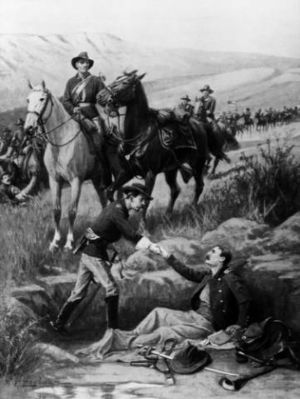
"The Rescue." A soldier offers aid to his wounded comrade after the Battle of Beecher Island.[1]
September 10
Forsyth (in the rank of Brevet Colonel) and his group departed Fort Wallace with orders to counter a raid on the Kansas Pacific rail head near Sheridan, Kansas some 13 miles east.
September 11–16
The scouts trailed the Indian raiding party from Sheridan into Colorado; signs indicated that the opposing force considerably outnumbered the scouts, but the unit nonetheless pressed on. Around dusk on the 16th Forsyth and his men arrived in the vicinity of the "Dry Fork of the Republican River" (reported at the time as "Delaware Creek"—now the Arikaree River) and made camp on the south bank.
September 17–19
Come dawn on the 17th, Forsyth (sensing trouble) spotted the silhouette of a feathered head against the skyline. He fired his weapon, instantly killing the Indian warrior. Simultaneously, other Indians that had moved nearer to where the scouts' horses were tied up attempted to stampede them, but the scouts immediately responded to the sound of Forsyth's gunshot and only the pack mules were lost. Roman Nose, war leader of the Cheyenne, had planned a dawn raid to overrun the camp of 50 U.S. scouts, but the element of surprise was lost when a few eager warriors rushed the camp before the order to attack was given. Forsyth gave orders to saddle the horses. Surmising that no escape route was open, he directed his men to take cover on a sand bar in the middle of the Arikaree. The attack of 200-300 warriors was repelled by the scouts' superior firepower. Roman Nose and many other warriors fell, while four of the scouts (Beecher, Acting Surgeon J.H. Mooers, George W. Culver, and William Wilson) were also killed. 15 scouts were wounded, among them Colonel Forsyth who received a head wound, a broken leg, and a gunshot wound in the unbroken thigh. During the first night Colonel Forsyth sent a few scouts to go summon assistance from Fort Wallace, more than 60 miles away.
September 20–24
Forsyth and his men sustain themselves on muddy river water and spoiling horse meat.
September 25–27
Elements of the 10th Cavalry Regiment under Lieutenant Colonel Carpenter arrive to relieve Forsyth's unit. The following day, a fifth scout dies of his wounds and is buried on the battlefield with the other four scouts (sixth died in hospital later). On the September 27 the "Forsyth Scouts" depart for Fort Wallace escorted by the 10th Cavalry.
Aftermath
The "Forsyth Scouts" arrived back at Fort Wallace on September 30. Brevet General George Armstrong Custer later proclaimed that the Arickaree fight was "…the greatest battle on the plains." To the Cheyenne, the engagement would be remembered as "The Fight when Roman Nose was Killed." In actuality, the fight was a minor engagement of no lasting import whose greater significance, as a model for tactics in successfully combating the Indians, was largely ignored. The location of the battle was designated as a National Historic Site in 1976.
Historic designations
- National Register of Historic Places #NPS–76000569 — "Beecher Island Battleground Memorial" site
- Colorado State Register Property
Notes and references
- ↑ The Harper's article states that this is Brevet Colonel Louis H. Carpenter greeting Lieutenant Colonel Forsyth, who was twice wounded.
